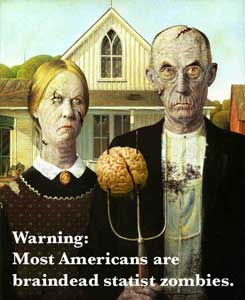
The Anarchist FAQ
Liberty is the mother, not the daugher, of order.
VI. What do anarchists do?
The nature of the State indicates which actions are likely to be successful. The anarchists' elitist model of political power - that the ruling elite make the decisions within the state apparatus - indicates that working "within the system" will not work. Most anarchists do not vote, since voting seems to condone the state and its immoral actions. Similarly, begging the politicians through signing petitions is all but futile. Anarchists prefer to destroy the state's mystique of legitimacy, not enhance it.
Anarchists support the tactic of “Direct Action” (see section I) for, as Emma Goldman argued,
[We have] as much liberty as [we are] willing to take. Anarchism therefore stands for direct action, the open defiance of, and resistance to, all laws and restrictions, economic, social, and moral.” [It requires] “integrity, self-reliance, and courage. In short, it calls for free, independent spirits [and] only persistent resistance” [can] finally set [us] free. Direct action against the authority in the shop, direct action against the authority of the law, direct action against the invasive, meddlesome authority of our moral code, is the logical, consistent method of Anarchism.” — Red Emma Speaks, pp. 76–7
VI.A - Education & Propaganda
Job number one is to destroy the state's aura of legitimacy. This means education, since the "aura" is in people's minds. So long as most people see the state as the solution rather than the problem, freedom cannot generally reign. We know from history that revolution will not likely help (and may well hurt) if people's minds are not already "right" for liberty.
Here are some things you can do to reduce sheeple's mental subervience to the State:
- Delegitimize the State.
- Promote liberty in your conversations.
- Promote liberty in public writings (letters-to-editors, web pages, articles, etc.)
- Correct others when they fall for statist bromides and myths.
- Correct others when they use the statist "we," or succumb to the Stateholm Syndrome.
- Avoid statist puffery in language.
- Challenge the statist paradigm and the us versus them warmonger flaghumger mentality.

VI.B. - Agorism and the Counter-economy
One very effective way to fight the State is to build parallel structures, particularly those that avoid or ignore government restrictions. This is referred to as the counter-economy - the sum total of all extra-legal economic behavior. Some anarchists, such as Samuel E. Konkin III, went so far as to say that pushers and prostitutes do more to promote anarchism that most self-proclaimed "armchair" anarchists. His book The New Libertarian Manifesto founded this agorist strategy.
The answer is agorism.It is possible, practical, and even profitable to entrepreneur large collections of humanity away from statist society to the agora. This is, in the deepest sense, true revolutionary activity and will be covered in the next chapter. To understand this macro answer, however, we must first outline the micro answer.
The function of the pseudo-science of Establishment economics, even more than making predictions for the ruling class (as did the Imperial Roman augurs), is to mystify and confuse the ruled class as to where their wealth is going and how it is taken. An explanation of how people can keep their wealth and property safe from the State, then, is Counter-Establishment economics, or Counter-Economics[25] for short. The actual practice of human actions that evade, avoid, and defy the State is counter-economic activity.
— Samuel Edward Konkin III, New Libertarian Manifesto
VI.C - Building Alternative Structures
Here are some of the areas in which anarchists are building alternatives to statist monopolies and currently captured services.Opportunities for Counter-institutions
|

|
Also see Claire Wolfe's 101 Things To Do 'Til The Revolution from her book by the same name, and Gene Sharp's Methods of Nonviolent Action.
Here are some areas of particular interest to anarchists today. (Slug. Needs elaboration.)
VI.C.1 - Crypto-currencies
Cryptocurrency confronts the banality of an economic system for which the word “evil” is not too strong a word. Opening with Arendt may seem like hyperbole, but it captures something important. The central banking system and the other economic controls imposed by government seem benign because they are so familiar; people grew up with them. And bank clerks can be very pleasant as they demand Know Your Customer data; if the customer objects, they answer “I am doing my job, and it is the law.” Nothing benign occurs in the system. Hard-working people are robbed of their wealth through measures like inflation and the monopoly of fiat currency; food is taken from the mouths of children; innovators who could produce a better world are shackled; in some nations, people die for want of nourishment or medical care. — Wendy McElroy, The Centralization of Crypto and the Banality of EvilVI.C.2 - Blockchain Trust - deeds and proofs and reputations
VI.C.3 - Local ownership, coops, and mutuals
VI.C.4 - Neighborhood arbitration and watches